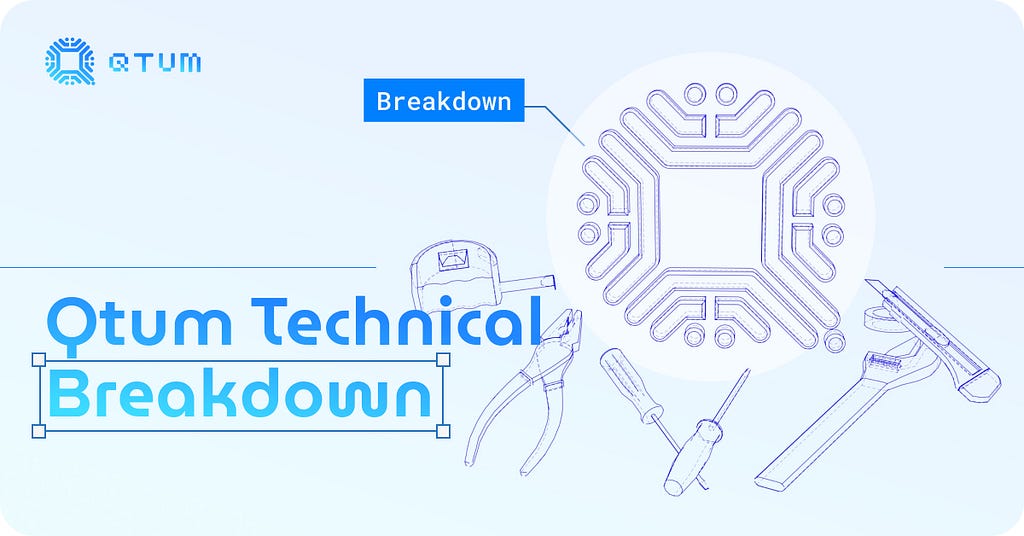Qtum Technical Breakdown
5
0

Qtum is one of the oldest crypto protocols out there and combines the functionalities of Bitcoin and Ethereum in one platform. To create this mix, Qtum uses:
- Bitcoin’s UTXO system
- Ethereum’s EVM
Also, the custom Proof of Stake (PoS) consensus mechanism has been made to target critical security issues.
Qtum and UTXO
For example, let’s say you have UTXOs in your wallet worth 0.4 BTC, 0.3 BTC, and 0.15 BTC. Now, if you send 0.6 BTC to your friend, your wallet will pick up the 0.4 BTC and 0.3 BTC UTXOs and send 0.6 BTC to your friend while returning 0.1 BTC as change. Your wallet will use 0.1 BTC and 0.15 BTC as its UTXO set for future transactions.
The UTXO model is a great way to combat double spending since you can see if an output has already been spent.
Qtum and EVM
The Ethereum Virtual Machine (or EVM) is the operating system of the Ethereum network. It is a piece of software that executes smart contract code. Basically, all the cool stuff on Ethereum, like DeFi and NFTs, is deployed via the EVM. It is a piece of software that computes the state of Ethereum.
Integrating the EVM allows Qtum to host a developer-friendly platform. Plus, Qtum has also implemented Janus, a Web3 interpretation layer. Solidity developers can work on Qtum in “Ethereum sandbox” mode, meaning the platform acts almost identically to Ethereum.
Qtum Consensus Algorithm
Qtum was one of the first UTXO-based systems to deploy a proof-of-stake (PoS) consensus algorithm. In PoS, the mining process becomes completely virtual. Instead of miners using real-world computational resources, we have validators “placing bets” on the winning block. The moment the block gets added, the validators get rewarded in proportion to their stake.
Here are some design details of Qtum’s PoS:
- It helps combat junk contract spam attacks.
- Shares block rewards between block-producing nodes and also delay the payment.
- Use of the reward is delayed for 2,000 blocks, making it difficult for attackers to exact rewards from a potential attack.
Qtum also introduced an offline staking mechanism in August 2020. Instead of giving up custody of your QTUM, you just need to share your wallet address. The coins remain in your wallet.
The staking system has two parties — Super Stakers (validators) and delegators.
- Delegators send their wallet address via a smart contract to a Super Staker.
- Super Staker has the choice to accept the delegation.
- If a Super Staker successfully validates a block, they will share a reward with their delegators and charge a fee.
- Super Stakers can charge the delegators a fee for staking.
Qtum fees
The gas model on Qtum protects the blockchain from attacks but tries to make it cheap enough for anyone to deploy Smart Contracts. The gas cost is denominated in Qtum Satoshis, the smallest unit of a QTUM token (1 Qtum Satoshi = 0.00000001 Qtum).
The actual fees you need to pay depends on network demand. However, community members can vote to change the parameters if the fees go out of control.
Important forks
Let’s go through some of the major hard forks in Qtum’s history.
Fast Lane
As the name suggests, the Fast Lane formed was deployed to speed up overall throughput. Due to the fork, the Qtum’s block spacing got slashed from 128 seconds to 32 seconds — effectively increasing overall network throughput by 400%. The fork was implemented on mainnet block 845,000 on April 30 at 5:30 am GMT.
First Halving
Like Bitcoin, Qtum also has halvings events wherein the block rewards are halved every four years — around 3,942,000 blocks for Qtum. Halving is a classic deflationary mechanism that periodically reduces the supply, increasing asset demand in the process. The first halving event happened on December 1, 2021, at Block 1,427,004. Following the event, Qtum block rewards have now dropped to 0.5 QTUM from 1 QTUM.
Other Qtum Updates
Taproot
One of the biggest advantages of Qtum is that we can implement both Bitcoin and Ethereum updates. One of the major Bitcoin updates that Qtum recently implemented is Taproot. What does Taproot do?
- It helps improve the privacy and efficiency of the Bitcoin network.
- Simplifies the creation and execution of smart contracts on the Bitcoin blockchain
The upgrade officially happened via a soft fork at block 709,632 on 14th November 2021.
EVM1
The EVM1 upgrade switched the EVM implementation to EVMone Fast Ethereum Virtual Machine. This codebase of evmone is improved to provide efficient and fast execution of EVM smart contracts.
Future of Qtum
Having created a scalable, EVM-based platform, Qtum now looks to expand its business use case into metaverse gaming. We are doing this with our partnership with Moonland meta. Moonland is an interactive multi-chain metaverse that is currently under development. It is a social multiplayer metaverse focused on social activity, shopping, fun, and games.
We believe that metaverse gaming is going to explode in the near future. As such, Qtum is positioning itself as a market leader through the Moonland partnership.
Qtum Technical Breakdown was originally published in Qtum on Medium, where people are continuing the conversation by highlighting and responding to this story.
5
0






